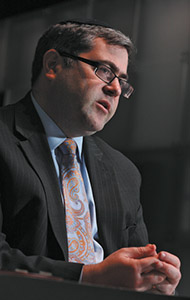

Bergenfield—If the Aish HaTorah founded by the late Rabbi Noah Weinberg and known as one of the world leaders in kiruv (Jewish outreach) can be called “Aish 1.0,” the beginning of “Aish 2.0” will begin on July 1.
That’s when Rabbi Steven Burg, 43, begins his long-awaited appointment as Director General of Aish HaTorah Jerusalem and Aish HaTorah globally. The organization that was started by Rabbi Weinberg in 1974 now has 35 branches around the world and hosts a highly regarded website, Aish.com.
Burg, who lives in Bergenfield with his wife, Rachel, and their six children, brings a stellar resume to the position. Burg worked for 22 years at the Union of Orthodox Jewish Congregations of America (OU). He was appointed the International Director of the National Conference of Synagogue Youth in 2005, thus becoming the youngest to ever hold that position.
It was his work in NCSY that broadened the scope of the organization’s mission, reaching many thousands of Jewish teens and sending many of them to summer learning experiences in Israel. Burg was also the founder of the Jewish Student Union (JSU), clubs set up in public high schools to reach unaffiliated youth. Burg would go on to become Managing Director of the OU, and then joined the Simon Wiesenthal Center as Eastern Director.
“Í cannot think of a better, more talented person than Rabbi Burg to lead Aish HaTorah into its next stage of development,” said Jerry Lieberman, Chairman of the Aish HaTorah search committee.
Burg said that the opportunity to lead Aish HaTorah came out of the blue six months ago. “I got a call from a search committee. Aish HaTorah was the furthest thing from my mind. But a lot of what they were looking for I had already done at NCSY and the OU. I’ve been in the Judaic aspect of work, the programmatic aspect and the business management side. The more I talked to the search committee, the more I fell in love with the organization and the board.”
According to Aish HaTorah, Burg’s mandate will include:
Setting the vision and direction of Aish HaTorah worldwide
Creating unity and synergy across the global Aish HaTorah network
Crafting new strategies to reach out and inspire world Jewry
Building and overseeing an efficient management structure
Burg said he comes into the position with a tremendous amount of respect and admiration for Rabbi Weinberg and the work he did to expand Aish’s branding and influence over the years.
“He was a class act,” said Burg. “He was driven to reach people, and he was the kind of person who would look at the world and see how it should be.”
It was Burg in his interview with the Jewish Link who described the coming mission as “Aish 2.0,” an Aish that will continue to grow in support of Jewish outreach. “I’ve been blown away by what I’ve seen so far,” he continued. “I could have not imagined how great Aish is. This is a dream come true.”
He said that in his career, though with Jewish organizations, he never attempted to label himself with just one strain of Jewish thinking.
“In my career, I’ve worked with the Agudath Israel, with Chassidic leaders, with people in the African American community. I’ve never had a problem working with people, from leadership to volunteers.”
So what is it that Burg sees as his first objectives in his new position?
“That is so hard to define,” he said. “There are so many good things going on. I think for me it’s going to be first identifying the programs having the most success and replicating them.” He gave as an example the work being done by Aish HaTorah New York. Aish flew in about 60 IDF soldiers who had been on Birthright busses with young adults who had taken part in the widely popular trip to Israel.
Aish’s goal was to bring the soldiers and young adults back together for a weekend of follow-up and reunion. The idea came about after a 2009 Brandeis study indicating that only four percent of Birthright participants had involved themselves with more than five Jewish events or activities.
Burg pointed to this program as a clear of example of how Aish can be successful in its outreach. “How do we make sure that our enormous organization is doing the right stuff and reaching people?” he asked. “The whole world has shifted over the years (in terms of technology). Now we have to work on great things using social media and new delivery systems.”
He also said that even with the high popularity of Aish.com, there is still room “to branch out more using social media as well as taking the content on our website and figuring out new ways to develop it.” Burg also talked about the building of the Western Wall Experience at Aish HaTorah in Jerusalem. Scheduled to open in about two to three years, he said, visitors will be offered a multimedia, 3-D, total immersion experience about Jewish history and prayer and then open a door and come out to the Western Wall. We have an entrance right outside to the Kotel plaza. We hope this will revolutionize the Kotel experience.”
Finally, the question had to be asked about Aish HaTorah’s kiruv role. Is the organization’s bottom line to lead unaffiliated Jews towards Orthodoxy?
Burg said he’s not so sure that image of Aish is true. “God gives people free will,” he said. “We’re here to present Judaism, and if someone wants, it then that’s great.”
Something great about the new job that not many in this world can say? “I have an office overlooking the Kotel,” said Burg. Burg added that his career all along was leading him to that office.
“Working for the OU and NCSY and then Wiesenthal literally put me on the track for this position. I just thank God that it was a fantastic global organization like Aish that called.”
By Phil Jacobs









